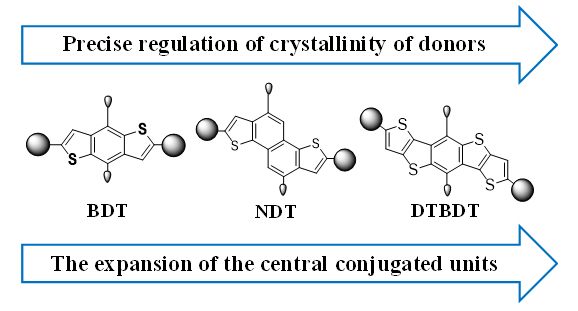摘要/Abstract

随着新型小分子给体材料和非富勒烯小分子受体材料的开发和应用, 非富勒烯全小分子有机太阳能电池(NF-ASM OSCs)的光电转换效率已经突破15%, 并逐渐接近聚合物太阳能电池的效率. 相比于聚合物电子给体材料, 小分子电子给体材料拥有其独特的优势, 例如合成批次性差异小、分子量明确和易于提纯等; 但是, 对小分子给体材料的结晶性难于精确调控, 使获得合适的纳米级结构的混合膜仍然是一个挑战. 本综述以给体小分子中心共轭单元的扩展为主线, 从分子设计的角度汇总了近年来对苯并二噻吩、萘并二噻吩和二噻并苯并二噻吩类小分子给体材料的结晶性研究, 并为进一步改善电池活性层形貌和获得更高的光伏性能提供了未来发展的建议.
关键词: 全小分子有机太阳能电池, 小分子电子给体材料, 中心共轭单元, 分子设计, 结晶性
In the past few decades, organic solar cells (OSCs) have been extensively studied due to their advantages of semitransparency, light-weight and flexibility, which are considered to be an important renewable energy source in the future. Recently, bulk heterojunction all-small molecule organic solar cells (BHJ ASM-OSCs) composed of p-type small molecule donors and n-type non-fullerene acceptors as the active layers have achieved remarkable development and the power conversion efficiencies (PCEs) have exceeded 15%. The advantages of non-fullerene acceptors over fullerene competitors are their easily tunable energy levels, better absorption properties and proper molecular designs, which allow ASM-OSCs to achieve significantly higher open-circuit voltages, higher photocurrents and superior stability, thus extending the device lifetime of OSCs. Compared with p-type polymer donors, p-type small molecule donors have unique advantages, such as well-defined molecular structures, easy purification and low batch-to-batch variations. Although ASM-OSCs are expected to take advantages of non-fullerene acceptors and small molecule donors simultaneously, in consequence of inappropriate crystallinity and nano-scale bi-continuous interpenetrating networks in blended films resulting from similar acceptor-donor-acceptor (A-D-A) structures and physicochemical properties between small molecule donors and non-fullerene acceptors, the PCEs of current state-of-the-art ASM-OSCs are still much lower than that of polymer-based OSCs. In this review, based on the expansion of the central conjugated units of small molecular donors, we summarized the crystallinity of benzodithiophene (BDT), naphthodithiophene (NDT) and dithienobenzodithiophene (DTBDT) donors from the perspective of molecular design and provided suggestions for further molecular design and morphology improvement.
Key words: all small molecule organic solar cell, small molecule donor, central conjugated unit, molecular design, crystallinity
PDF全文下载地址:
点我下载PDF
